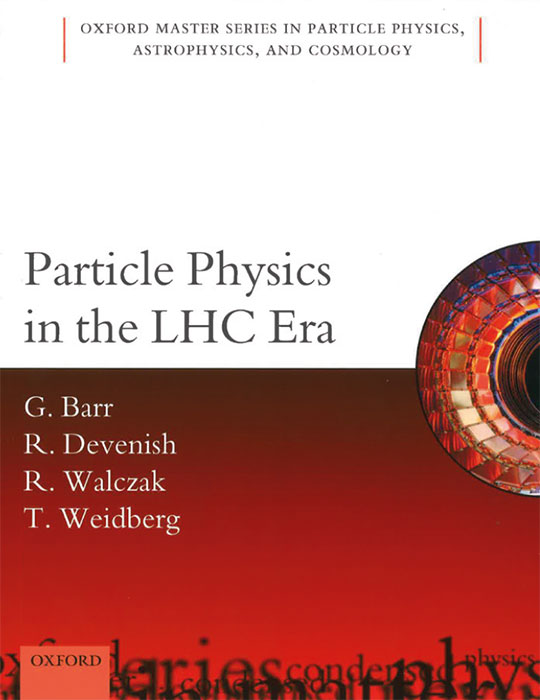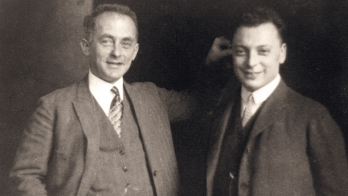By G Barr, D Devenish, R Walczak and T Weidberg
Oxford University Press

This book’s aim, as stated in the introduction, is to provide a practical introduction to particle physics in the LHC era at the level of an advanced undergraduate or introductory graduate course. Indeed, in its almost 400 pages, it covers a wide range of topics, from instrumentation and detector technologies to some mathematical techniques and the traditional particle-physics topics that are usually included in similar textbooks. It hovers, by design, at the border between the established textbooks aimed at undergraduates and the more advanced graduate texts that often start with quantum field theory.
Following the introduction, the book commences with a three-chapter sequence with somewhat technical content. Chapter 2, dedicated to mathematical methods, covers discrete symmetries, angular momentum and rotations in space, Lorentz invariance and the calculation of phase-space factors, decay widths and cross-sections, and concludes with a brief review of group theory. Chapter 3, on accelerators, includes a concise yet clear description of the basic concepts and terminology often encountered by students starting to work on experiments but not readily available. The topics include synchronicity, beam optics, Q values and beam tunes, luminosity, and even some characteristics of past accelerators. Chapter 4 is on particle detectors. Beyond the standard topics expected in such an overview, e.g. the interaction of particles and radiation with matter, the chapter includes topics that are usually neglected, including short presentations on signal generation, triggering of experiments and the selection of a magnetic field. As would be expected, calorimetry is well covered, as are tracking detectors, to which an extensive description, including an introduction to solid-state detectors, is included. The topics and detector examples provided are too centred on the LHC and its experiments, though.
Chapter 5, on the static quark model, is the first “particle-physics-proper” section. It’s a clear and self-contained introduction to mesons and baryons, with a modern perspective. The authors have decided to include heavy quarks (with the exception of the top quark) and their mesons and baryons, and the result is a full overview for the reader. Finally, chapter 6 on relativistic quantum mechanics concludes what could be called the first part of the book on “concepts, tools and methods”. There is a modern angle in this chapter: as an example, Weyl spinors are introduced and used, along with the associated Lorentz transforms and spin matrices. This material is better absorbed by graduate students. The rest of the chapter covers the traditional Klein–Gordon and Dirac equations, and introduces the electromagnetic interaction. It concludes with a short introduction to gauge symmetry.
Chapters 7–10 constitute a second part that concentrates on particle physics. Chapter 7, on weak interactions, covers all of the material from the four-point Fermi interaction to the Standard Model (SM), although without symmetry breaking. The descriptions of V–A, parity violation and the weak interactions of quarks, the CKM matrix and hadron decays via the weak interaction are clear, as is the extended introduction of SU(2) × U(1) symmetry as the basis of the SM. Chapter 8, on experimental tests of electroweak theory, is one of the more modern presentations of the topics covered: it starts with neutrino interactions and charged and neutral currents, and moves to Z physics and then WW production at LEP. It includes some experimental aspects such as the use of resonant depolarisation for the precise determination of the LEP beam energy. Moving away from convention, the discovery of the W and Z bosons at the CERN SPS is left for after the LEP presentation. The chapter concludes with a brief presentation of the discovery of the top quark and some later results from the Tevatron.
Chapter 9, on dynamic quarks, breaks the flow slightly. It contains Rutherford scattering, the quark–parton model and neutrino interactions, and concludes its first part with electron–nucleon deep inelastic scattering. This is a departure from standard practice in most textbooks. The second part of the chapter is on the introduction of colour, QCD, parton distribution functions and hadron–hadron collisions, and the Drell–Yan process. The material, which is extensive but presented quite briefly, is more appropriate for undergraduates.
Chapters 10 (oscillations and CP violation in meson systems) and 11 (neutrino oscillations) are great introductions to physics mixing, both in the quark and the lepton sector. The discussion in chapter 10 is modern, with results from experiments at LEP, the B factories and hadron colliders. Chapter 11 has one of the best summaries on neutrino physics for this level: it starts with the first evidence of mixing in atmospheric neutrinos, and proceeds to laboratory experiments, and then the MSW effect, solar-neutrino oscillations and then three-flavour oscillations, concluding with the measurement of θ13. This chapter is a novel and useful addition to the textbook.
Chapter 12 is on the Higgs boson. It starts with a short introduction to spontaneous symmetry breaking and proceeds to a description of the discovery of the Higgs boson by the ATLAS and CMS experiments. The material, with the exception of a section on the statistical significance, which is too short and ill-placed to be useful, is at the right level for the advanced-undergraduate-to-graduate student audience.
The book concludes with chapter 13 on the LHC and BSM (physics Beyond the Standard Model). It has an interesting selection of topics, including expected ones like supersymmetry and some unexpected ones (for a textbook) like the search for new contact interactions and new resonances. The approach is quite experimental in that only the motivation for new phenomena is presented, and the theory is skipped. It is nevertheless a useful introduction to the subject, adequate for motivating students to explore further.
Overall, the book achieves its goal of bridging the gap between undergraduate and graduate textbooks. The descriptions of the various topics are mostly clear, although at times too short. In a formal course, the tutor would probably choose to cover the material in a slightly different mix to the order it is presented here, combining material from the first part (chapters 2–6) and the second part (mainly chapters 7–10). In summary, this is a welcome, useful and modern addition to the current list of textbooks in particle physics.








